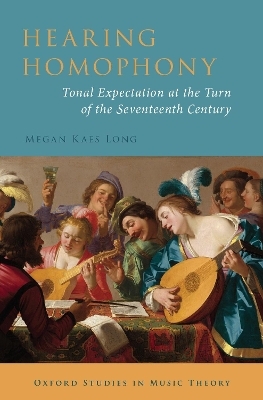
Hearing Homophony
Tonal Expectation at the Turn of the Seventeenth Century
Seiten
2020
Oxford University Press Inc (Verlag)
978-0-19-085190-3 (ISBN)
Oxford University Press Inc (Verlag)
978-0-19-085190-3 (ISBN)
In Hearing Homophony, Megan Kaes Long presents a groundbreaking model for understanding tonality and its origins, examining it through the lens of popular songs of late-Renaissance Western Europe.
The question of tonality's origins in music's pitch content has long vexed many scholars of music theory. However, tonality is not ultimately defined by pitch alone, but rather by pitch's interaction with elements like rhythm, meter, phrase structure, and form. Hearing Homophony investigates the elusive early history of tonality by examining a constellation of late-Renaissance popular songs which flourished throughout Western Europe at the turn of the seventeenth century. Megan Kaes Long argues that it is in these songs, rather than in more ambitious secular and sacred works, that the foundations of eighteenth century style are found. Arguing that tonality emerges from features of modal counterpoint - in particular, the rhythmic, phrase structural, and formal processes that govern it - and drawing on the arguments of theorists such as Dahlhaus, Powers, and Barnett, she asserts that modality and tonality are different in kind and not mutually exclusive.
Using several hundred homophonic partsongs from Italy, Germany, England, and France, Long addresses a historical question of critical importance to music theory, musicology, and music performance. Hearing Homophony presents not only a new model of tonality's origins, but also a more comprehensive understanding of what tonality is, providing novel insight into the challenging world of seventeenth-century music.
The question of tonality's origins in music's pitch content has long vexed many scholars of music theory. However, tonality is not ultimately defined by pitch alone, but rather by pitch's interaction with elements like rhythm, meter, phrase structure, and form. Hearing Homophony investigates the elusive early history of tonality by examining a constellation of late-Renaissance popular songs which flourished throughout Western Europe at the turn of the seventeenth century. Megan Kaes Long argues that it is in these songs, rather than in more ambitious secular and sacred works, that the foundations of eighteenth century style are found. Arguing that tonality emerges from features of modal counterpoint - in particular, the rhythmic, phrase structural, and formal processes that govern it - and drawing on the arguments of theorists such as Dahlhaus, Powers, and Barnett, she asserts that modality and tonality are different in kind and not mutually exclusive.
Using several hundred homophonic partsongs from Italy, Germany, England, and France, Long addresses a historical question of critical importance to music theory, musicology, and music performance. Hearing Homophony presents not only a new model of tonality's origins, but also a more comprehensive understanding of what tonality is, providing novel insight into the challenging world of seventeenth-century music.
Megan Kaes Long is Assistant Professor of Music Theory at Oberlin College Conservatory of Music. Her work explores sixteenth- and seventeenth-century secular song traditions, the theories that describe them, and the ways in which they inform the histories of modality and tonality.
Acknowledgements
About the Companion Website
Chapter 1: How We Got into Harmonic Tonality, and How to Get Out
Chapter 2: La questione della lingua: Transmission and Translation of Musical Style
Chapter 3: The Work of the Words
Chapter 4: Halves Requiring Completion
Chapter 5: From Phrase Structure to Form: The Balletto
Chapter 6: Tonal Orientation: New Tools for Navigating the Formal Landscape
Chapter 7: Humanism and the Invention of Homophony
Epilogue
Bibliography
Index
| Erscheinungsdatum | 07.05.2020 |
|---|---|
| Reihe/Serie | Oxford Studies in Music Theory |
| Zusatzinfo | 72 music examples, 42 figures |
| Verlagsort | New York |
| Sprache | englisch |
| Maße | 239 x 155 mm |
| Gewicht | 558 g |
| Themenwelt | Kunst / Musik / Theater ► Musik ► Klassik / Oper / Musical |
| Kunst / Musik / Theater ► Musik ► Musiktheorie / Musiklehre | |
| ISBN-10 | 0-19-085190-2 / 0190851902 |
| ISBN-13 | 978-0-19-085190-3 / 9780190851903 |
| Zustand | Neuware |
| Informationen gemäß Produktsicherheitsverordnung (GPSR) | |
| Haben Sie eine Frage zum Produkt? |
Mehr entdecken
aus dem Bereich
aus dem Bereich
Essays und Gespräche
Buch | Hardcover (2025)
Wallstein Erfolgstitel (Verlag)
CHF 29,90


